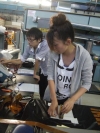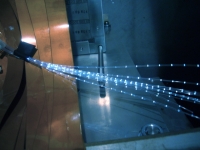 |
 |
|||||||||||||
|
|||||||||||||
|
|||||||||||||
|
The International Linear Collider requires a detector with excellent performance to fully exploit its physics potential. In order to meet this challenge, significant improvements in the calorimetric performance are needed compared to previous generations of detectors, and new technologies and techniques are being developed. To test those technologies and techniques with particle beams, scientists are travelling around the world, to where beamlines with particle beams for tests are available. The team of Japanese, Korean, German and English scientists working on the development of the electromagnetic calorimeter (ECAL) in CALICE international collaboration has just completed their beam test in Fermilab. “This time, it is four times larger,” said Tohru Takeshita, scientist at Shinshu University, Japan. The calorimeter is twice as big both lengthwise and widthwise. The group have already conducted some test on the parts for this bigger calorimeter using DESY's beam line in March 2007, but this is the first time for the full detector with a 100 percent Korean-made scintillator. “Korean team developed the scintillators, and we developed optical sensors in Japan, carried them to Fermilab and put them together there to test,” Takeshita said. The primary purpose of the ECAL is to reconstruct individual photon showers and measure photon energies in the event. A photon shower, being electromagnetic in nature, can be described analytically with energy deposition from the shower core. “We need to make sure that each readout channels are working properly to collect reliable data,” said Takeshita. The team used electron beam for this test. The electron energies in each beamline are fixed, therefore incident energy and measured energy should correspond. The team has tested its prototype with low-energy beam at DESY and higher energy at Fermilab, and both tests showed that the machine is working well. They also tested their calorimeter with neutral pions at Fermilab, which are only available in this lab. Another challenge of the ECAL is the fine sampling of photon showers. The scientists are seeking to build a fine-granularity calorimeter with a large number of segmentations for this challenge. “This calorimeter has 2,000 segmentations to sample photon showers,” said Takeshita. For the gain monitoring system, to avoid having to wire thousands of fibre cables to each segmentation, they did a little trick: they cut the notches onto the optical fibres. Usually, optical fibres are used to carry light along, but this time they are used to emit light. Each scintillator will catch emitted light from the notch on the cable, which makes it possible to test all 2,000 scintillators at the same time. The test result will be analysed after scientists are back in Japan. “We would like to come back to Fermilab next spring,” they said. By that time, they will know which additional tests they will need to conduct. -- Rika Takahashi |
|||||||||||||
| © International Linear Collider |

